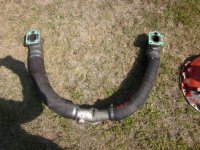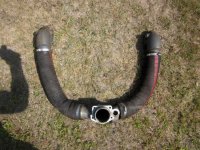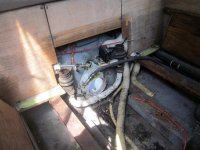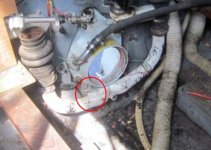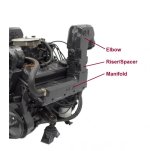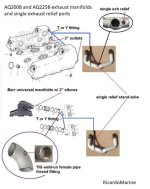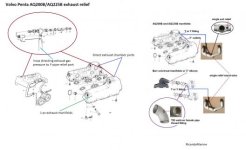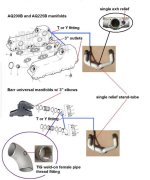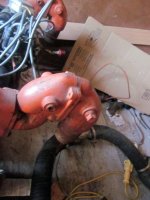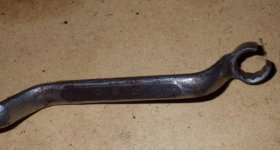Here's a a typical
heat riser with elbow setup.
View attachment 18598
The part that is being shown between the exhaust manifold and the elbow is a spacer or riser.
Not all exhaust systems use a spacer/riser.
I posted photos of the exhaust setup with sealed off
auxiliary port which you indicate is probably for back pressure relief when the boat is sitting idling. Makes sense.
Yes, that would be a low pressure exhaust relief port..... (not an auxiliary port).
I see at the end of each manifold there are large ports sealed up with plugs and presumably I can simply pick up two threaded hose attachments, hi-temp hose, and clamps to connect the left side manifold to the sealed off back pressure relief port at the exhaust fitting connected to inside of transom shield (see my second response with photo of it circled) .
Actually, the original elbows (had they been Volvo Penta) would have been ported from directly within the exhaust gas chamber...... not from within the seawater side.
Volvo Penta did this for the GM 5.0L V-8s with the AQ200B and the AQ225B.
Chrysler apparently followed suit using their own components, or possibly Eaton components.
Good to know what that plugged port was used for. I wonder why it was sealed off? The solid Y-tube exhaust, supposedly from a 280 outdrive, is rather narrow diameter but for my purposes I don't think it will be a big issue.
The 3" Y-pipe was used with the smaller 335 series Fords and the smaller GM v-8s.
Again, Chrysler apparently adapted the use of this part for their 318.
Typically the 360 would have been equipped with a larger diameter Y-pipe.
This is a fishing/camping cruiser, not a speed boat. I'm also thinking the back pressure relief while idling issue might have been more important for maintaining idle of lower hp 318. Maybe not so much for the larger engine?
Not necessarily. It was used as to prevent engine fuel-load-up while at trolling speeds and/or while docking, etc.
If this Y-tube doesn't work out I can simply switch back to the old setup with longer exhaust hoses to meet risers (and some 45 degree solid exhaust joints rather than bending the hose). The probability of finding a larger 280 Y-tube exhaust is rather remote in this remote backwater.
Yes, that may be hard to find. Even if you were to find a double relief 95mm Y-pipe, it will be specific to the double-exhaust-relief 280 transom shield. If you were to find a good used 280 double relief transom shield, they tend to fetch around $800 or so.
Your transom shield offers a single relief only, which means that you are limited to the smaller single relief Y-pipe.
Again, what is the purpose of the risers?
Risers or Spacers are used to separate and raise the Elbow up from the manifold's mating surface.
This is done in scenarios whereby the water-line is too close to the Elbow's interior "turn-down-bend". Deep V hulls whereby the engine sits low in the hull.
The idea is to get the Elbow elevated as to prevent a wave-surge from forcing water into a cylinder at low speed.
Somewhere I have an image that I put together that will show how the low pressure exhaust relief is plumbed into the Y-pipe's relief port.
If I can find it, I will post it.
Another option for you would be to go with Thru-Transom exhaust.


